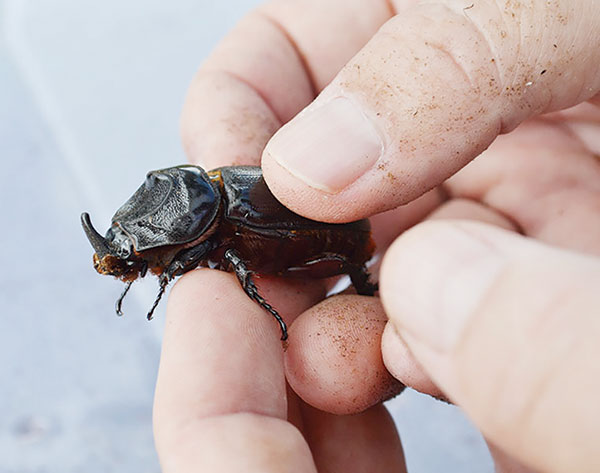Strides seen in ridding NMI of rhino beetles
Efforts to rid the CNMI of invasive coconut rhinoceros beetles is being tentatively described as a success, with little to almost no beetles uncovered every two months since a whole bunch was discovered on Rota in October 2017.
According to Lands and Natural Resources Secretary Anthony Benavente, efforts to eradicate coconut rhino beetles that have infested Rota’s coconut trees is proving fruitful.
“We are doing good. Every two months we find one. …Before, in a month, we would find three adults…but now, in two months, we didn’t find anything, then near the end of those two months, we catch lke one,” he said.
Benavente said the department went all out and attacked the problem early on, and that led to their present success. Breeding traps were immediately deployed on Rota soon after the beetles were discovered in Oct. 2017.
He said the DLNR increased the number of traps placed in the quarantined area to control the infestation and an islandwide visual survey for signs of coconut rhino beetle presence was conducted.
Benavente said the infected trees remain standing and will survive the attack.
Also contributing to their efforts on Rota is the habitat. “There is a good possibility that our wildlife habitat on Rota is attacking the coconut rhino beetles’ production. …Something seems to be eating the eggs. …We are very lucky here in the CNMI because we don’t have snakes, so there are predators that attack the rhino beetles., unlike Guam, where all these predators that are attacking the rhino beetles are being eaten up by the snakes. That is why we have to be very protective of our islands from snakes,” said Benavente.
The department has also been vigilant in keeping invasive species out of the CNMI like the brown tree snake.
“There is money that the federal government is providing us to really make sure we prevent them from coming in here. … It could take just a boat ride…or an airline. It could be the military. That is why when these things come in, our brown tree snakes dogs are out there,” he said.
The federal government has allotted $181,000 for the eradication of the rhino beetles and has allotted about $400,000 against brown tree snakes entering the CNMI.
Last October 2017, the department discovered the presence of 20 adult rhino beetles and multiple grubs on Rota when a coconut tree fell to the ground at the Tweksberry Beach Park, southwest of the West Marina on Rota.




























